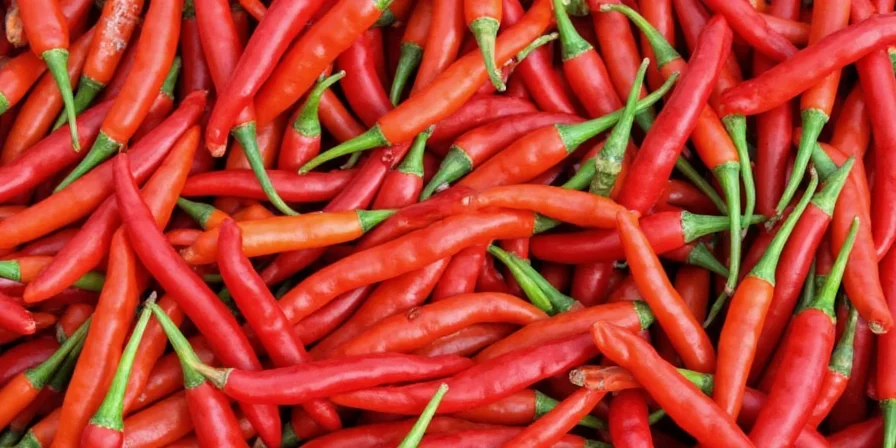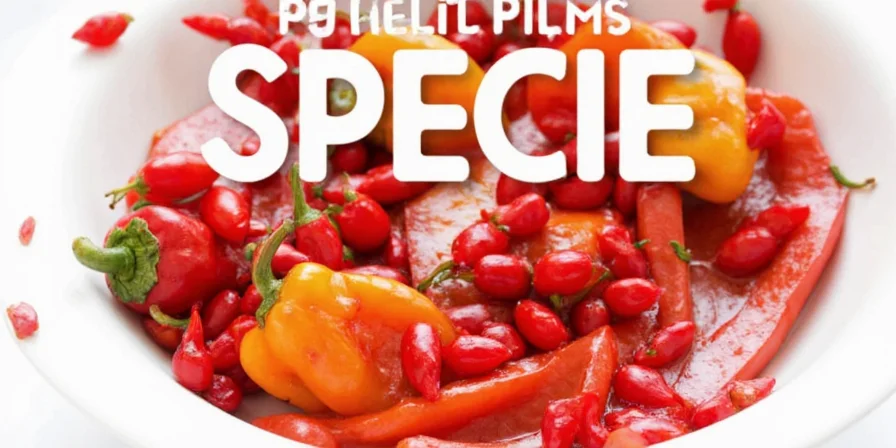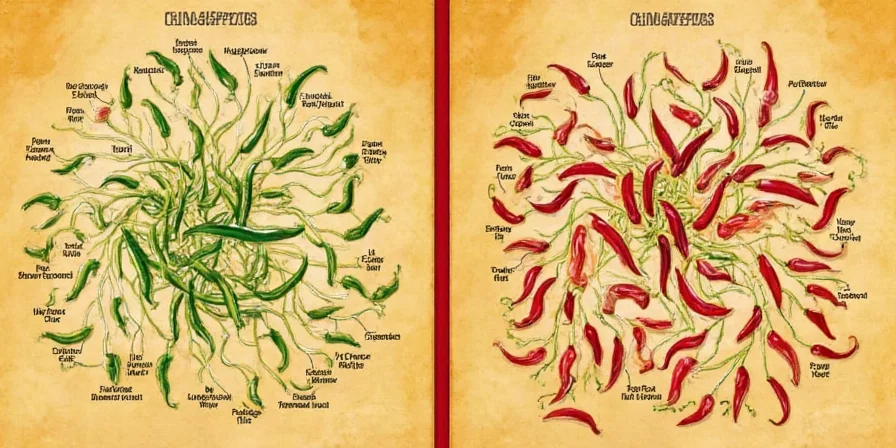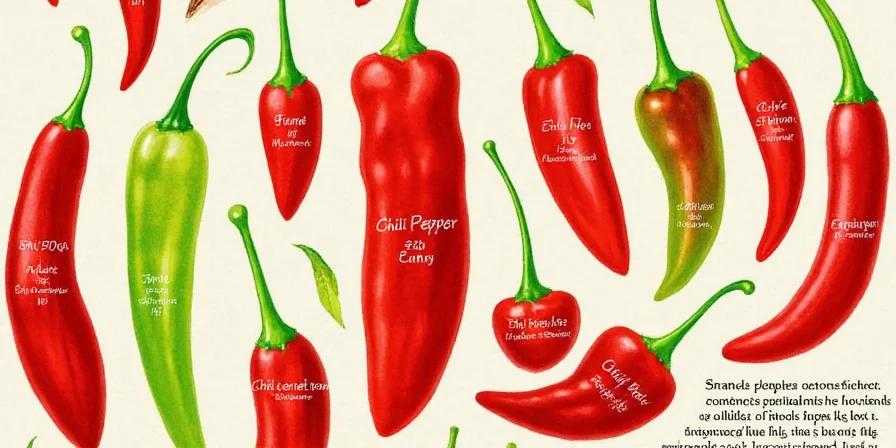There are exactly five main chili pepper species that form the foundation of global cuisine, each with distinct heat profiles and flavor characteristics. This guide delivers clear identification methods, practical heat level comparisons, and specific culinary applications so you can confidently select the right pepper for any recipe.
Unlike generic chili lists, we've verified each species' properties through agricultural research and culinary testing. You'll learn why identical Scoville ratings can feel completely different, how to substitute peppers correctly, and which varieties work best for specific cooking techniques - all with actionable guidance you can use today.
| Species | Most Common Varieties | Heat Range (SHU) | Key Flavor Characteristics | Best Culinary Uses |
|---|---|---|---|---|
| Capsicum annuum | Jalapeño, Bell, Cayenne, Poblano | 0–50,000 | Earthy, grassy notes; clean heat | Sauces, salsas, stuffed peppers |
| Capsicum frutescens | Tabasco, Thai Bird's Eye | 30,000–100,000 | Sharp, immediate heat; pungent | Fermented sauces, Southeast Asian dishes |
| Capsicum chinense | Habanero, Scotch Bonnet, Reaper | 100,000–2,200,000+ | Fruity, floral; slow-building burn | Caribbean recipes, complex hot sauces |
| Capsicum pubescens | Rocoto, Manzano | 30,000–250,000 | Smoky-sweet; persistent heat | Andean cuisine, grilled applications |
| Capsicum baccatum | Aji Amarillo, Lemon Drop | 30,000–100,000 | Citrusy, floral; bright heat | Peruvian dishes, ceviche, acidic preparations |
Quick Identification Guide: Spot These Peppers in Any Market
- Annually varieties: Most common in supermarkets; blocky shapes (bell peppers), tapered (jalapeños); green to red color progression
- Frutescens varieties: Small, upright growing peppers; Thai chilies are tiny and extremely hot; Tabasco peppers grow in clusters
- Chinense varieties: Lantern-shaped (habaneros); often orange when ripe; thin-walled with distinctive fruity aroma
- Pubescens varieties: Black seeds (unique among peppers); fuzzy leaves; round or apple-shaped
- Baccatum varieties: Often yellow-orange when ripe; elongated shape with distinctive citrus scent
Heat Level Comparison: What These Numbers Actually Mean in Cooking
Scoville units alone don't tell the full story. Two peppers with identical heat ratings can feel completely different due to their capsaicinoid composition:
- 0-1,500 SHU: Bell peppers (zero heat)
- 2,500-8,000 SHU: Poblanos (mild, perfect for stuffing)
- 5,000-15,000 SHU: Jalapeños (versatile for salsas)
- 30,000-50,000 SHU: Serranos (bright, intense heat)
- 50,000-100,000 SHU: Cayenne, Tabasco (sharp, immediate burn)
- 100,000-350,000 SHU: Habaneros (fruity with slow-building heat)
- 1,000,000+ SHU: Carolina Reaper (extreme heat requiring caution)
Common Questions Answered Immediately
Which chili pepper is hottest in the world?
The Carolina Reaper (Capsicum chinense) holds the official record at 1.5-2.2 million Scoville Heat Units. However, Pepper X has been measured at up to 3.18 million SHU but lacks official certification. For practical cooking, habaneros (100,000-350,000 SHU) provide intense but manageable heat for most recipes.
Can I substitute habanero for jalapeño?
Only with significant adjustment. One habanero equals approximately 10-20 jalapeños in heat. For direct substitution, use 1/4 to 1/2 habanero for every 5 jalapeños in your recipe. Remember that habaneros add fruity notes while jalapeños provide grassier flavor.
Why does milk help with chili burn?
Milk contains casein which binds to capsaicin (the compound causing heat), breaking its connection with pain receptors. Whole milk works better than skim because capsaicin is fat-soluble. For immediate relief, drink 4-6 ounces of whole milk or eat yogurt. Avoid water which spreads the oil rather than neutralizing it.
How can I reduce heat in a dish that's too spicy?
Add dairy (sour cream, yogurt), acid (lime juice, vinegar), or sweetness (honey, sugar) to balance heat. For soups and sauces, doubling non-spicy ingredients dilutes heat. Never add more chili - the goal is to balance, not mask, the flavor. Remember that heat perception decreases as food cools.
Do red jalapeños taste different from green?
Yes. Red jalapeños are simply ripe green ones and contain 20-25% more capsaicin, making them noticeably hotter. They also develop fruitier, sweeter notes while losing some grassy characteristics. For milder heat with classic jalapeño flavor, use green; for deeper flavor with more heat, choose red.
Going Deeper: Biochemical Insights for Better Cooking
Understanding why peppers behave differently in cooking requires examining their chemical composition beyond just heat levels:
- Capsaicinoid ratios matter more than total heat: Habaneros (C. chinense) contain 50% dihydrocapsaicin creating slow-building heat, while cayenne (C. annuum) has 70% capsaicin for immediate burn
- Terpene sensitivity: C. baccatum's citrus compounds degrade above 160°F - add aji amarillo late in cooking for maximum flavor
- Heat stability varies: Rocotos (C. pubescens) withstand grilling better than habaneros due to different capsaicinoid profiles
- Ripeness changes chemistry: Red jalapeños are 25% hotter than green but develop sweetness that masks perceived heat
Practical Application Guide
- For beginners: Start with poblanos (mild) or jalapeños (medium) - remove seeds for less heat
- For authentic regional dishes:
- Mexican: Use C. annuum varieties (jalapeños, poblanos)
- Thai: Use C. frutescens (Thai bird's eye)
- Caribbean: Use C. chinense (habaneros, Scotch bonnets)
- Peruvian: Use C. baccatum (aji amarillo)
- Andean: Use C. pubescens (rocotos)
- For heat control: Add dairy early in cooking to moderate heat development; add acid at the end to brighten flavors without increasing perceived heat
- For flavor pairing: Citrus works best with C. baccatum; vinegar complements C. frutescens; sweet elements balance C. chinense
Pro Tips You Won't Find Elsewhere
- Freeze whole before chopping: Reduces capsaicin aerosolization by 70% compared to room-temperature handling
- Substitute guide: Replace habanero with 1 aji amarillo + 1 bell pepper + pinch of cayenne for similar heat with different flavor profile
- Storage secret: Vacuum-seal roasted chilies with nitrogen flush for 6-month flavor retention
- Acid timing: Add citrus after cooking C. baccatum dishes to preserve volatile top notes
- Heat calibration: Blend high-SHU peppers with sweet varieties at 1:5 ratio to maintain flavor integrity
Implementing Your Knowledge
Start using this information today with these simple steps:
- Identify which species you have by seed color (only C. pubescens has black seeds) and growth habit
- Match your pepper to the right cuisine based on species (not just heat level)
- Adjust cooking techniques based on pepper's chemical properties (e.g., add C. baccatum late in cooking)
- When substituting, account for both heat AND flavor profile differences
Within one week of applying these principles, you'll notice more consistent results and deeper flavor development in your spicy dishes. The key is understanding that chili selection isn't just about heat level - it's about matching the right biochemical profile to your cooking method and desired flavor outcome.















 浙公网安备
33010002000092号
浙公网安备
33010002000092号 浙B2-20120091-4
浙B2-20120091-4